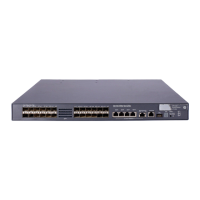61
4. Initial state of each device
Table 12 Initial state of each device
Device Port name Configuration BPDU on the port
Port A1 {0, 0, 0, Port A1}
Device A
Port A2 {0, 0, 0, Port A2}
Port B1 {1, 0, 1, Port B1}
Device B
Port B2 {1, 0, 1, Port B2}
Port C1 {2, 0, 2, Port C1}
Device C
Port C2 {2, 0, 2, Port C2}
In Table 12, each configuration BPDU contains the following fields: root bridge ID, root path cost,
designated bridge ID, and designated port ID.
5. Comparison process and result on each device
Table 13 Comparison process and result on each device
Device Comparison process
Configuration BPDU on
ports after comparison
Device A
• Port A1 receives the configuration BPDU of Port B1 {1, 0,
1, Port B1}, finds that its existing configuration BPDU {0,
0, 0, Port A1} is superior to the received configuration
BPDU, and discards the received one.
• Port A2 receives the configuration BPDU of Port C1 {2, 0,
2, Port C1}, finds that its existing configuration BPDU {0,
0, 0, Port A2} is superior to the received configuration
BPDU, and discards the received one.
• Device A finds that it is both the root bridge and
designated bridge in the configuration BPDUs of all its
ports, and considers itself as the root bridge. It does not
change the configuration BPDU of any port and starts to
periodically send out configuration BPDUs.
• Port A1: {0, 0, 0, Port
A1}
• Port A2: {0, 0, 0, Port
A2}

